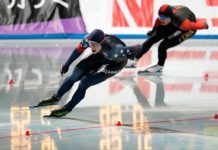★ The Sports Examiner: Chronicling the key competitive, economic and political forces shaping elite sport and the Olympic Movement.★
★ To get the daily Sports Examiner Recap by e-mail: sign up here! ★
≡ THE 5-RING CIRCUS ≡
● Paralympic Games 2028: Los Angeles ● The LA28 organizers have conducted two “NOC Open Days” for National Olympic Committees so far, but have delegates from some of the National Paralympic Committees in Los Angeles on Tuesday and Wednesday for presentations and tours.
These “NPC Open Days” feature visits to downtown Los Angeles venues such as the Los Angeles Memorial Coliseum, Los Angeles Convention Center, the Galen Center at the University of Southern California, the Long Beach Convention Center and, of course, the Paralympic Village at UCLA.
● International Olympic Committee ● IOC President Kirsty Coventry (ZIM) reiterated her call for access to sport at a keynote address to the European Olympic Committees in Brussels (BEL):
“Sport must remain a beacon of hope – a place where people can come together in peaceful competition. This is the essence of Olympism: every eligible athlete, team and official must be able to take part without discrimination or political interference.”
She specifically called on host countries and event organizers to pay attention, stating “They must guarantee access for all and respect the universality and autonomy of sport,” and related it to her own experience in Zimbabwe:
“If you had decided to sanction me when my country was going through turmoil, I would not have made it to the Olympic Games. I would not have won my Olympic medals. My path would have been completely different than it is today. Sport changed my life. And I am so grateful for that, and I will fight every day to ensure athletes from every corner of our world have the same possibilities.”
● Athletics ● The Jamaica Gleaner came out with an editorial which questioned the impact on athletes of the announced 2028 Olympic women’s 100 m squeezed into a single day on 15 July 2028. The opinion piece included:
“This newspaper clearly appreciates the additional attention that this scheduling might give the women’s sprinting.
“However, beyond the hoopla, there are questions about the broader implications of the move which deserve answers and which we hope were raised with World Athletics and the IOC by the relevant Jamaican sporting bodies, specifically, the Jamaica Athletics Administrative Association (JAAA) and the Jamaica Olympics Association (JOA). These include what were the considerations for athletes’ health in this compressed format for the women’s 100 metres sprint in Los Angeles; the expectations of performance at these games (and at future competitions if the initiative becomes locked in); and what are the prospects of sprinters breaking world records at events where the preliminary rounds and the final take place within hours, on the same day.
“Elite sprinting is a physiologically gruelling endeavour. Athletes place their bodies – particularly the legs and, most critically, the hamstrings – under tremendous stress. These muscles rapidly contract to drive the leg backward, propelling the body forward with explosive force. At the end of each stride, the muscles must reverse course, decelerating the limb, preparing it to repeat the cycle. That happens in milliseconds.
“This dual demand – forceful propulsion and precise braking – makes the hamstrings both the engine and the safeguard of the sprint. This stress makes these muscles susceptible to injury during races.
“But while the hamstrings bear the major burden of the explosion required in sprinting, the entire musculoskeletal system – from the lower back to the tips of the toes – is engaged and strained. Every stride taken by an athlete transmits force through the spine, hips, knees, ankles, and feet. This brings a wide range of muscles and joints into play. All of them suffer fatigue and are vulnerable to injury.
“If not given sufficient time to recover from one race, the more susceptible they will be to injury in the next. Or, the less likely it is that an athlete will deliver her peak performance. …
“With their modern support systems, elite athletes can, through a range of interventions, achieve muscle recovery within 30 minutes to an hour of a race. However, full neuromuscular recovery (where the operations centre in the brain and the spinal cord transmits messages to functional muscles) can take between 24 and 48 hours.
“This matters.”
● Bobsled & Skeleton ● The Italian government’s Olympic construction oversight arm, known by the abbreviation SIMICO, received good news at a ceremony on Tuesday at the new Eugenio Monti Sliding Center in Cortina d’Ampezzo:
“On this occasion, the International Bobsleigh, Skeleton, and Luge Federations presented the Sliding Center with its certifications, certifying its technical suitability and compliance with international standards and regulations.”
So, this track, delayed so long in development and execution, is ready for competition and the IBSF World Cup for bobsled and skeleton this weekend. It’s the first World Cup to be held in Cortina since January 2008 and the new track performed very well during the 120 runs taken during the International Training Week from 7-16 November.
● Boxing ● Impressive turnout for the USA Boxing National Championships coming 6-13 December in Lubbock, Texas, with registration now closed with the limit of 1,000 entries reached in about six weeks since the 1 October opening.
Another 100 are wait-listed for the tournaments at the Lubbock Memorial Civic Center.
● Football ● FIFA noted that its campaign against social-media abuse has led to identification of “11 individuals [who] have been reported to global law enforcement authorities in Argentina, Brazil, France, Poland, Spain, the United Kingdom and the United States following abuse during FIFA competitions, and one case was submitted to Interpol.”
A total of 30,000 posts were flagged by the FIFA Social Media Protection Service so far in 2025.
In addition, “for all identified cases, FIFA is blacklisting individuals responsible for highly abusive behaviour, aiming at preventing them from purchasing tickets for any future FIFA tournaments or events.”
¶
The U.S. men’s National Team faced 15th-ranked Uruguay – a 2026 World Cup qualifier – in a friendly in Tampa, Florida on Tuesday evening in the final match of the November international window, with one of its most impressive performances in years.
The U.S. got a brilliant first goal in the 17th off a free kick in the Uruguay end, with midfielder Sebastian Berhalter sending the ball to midfielder Sergino Dest, who passed it right back and Berhalter stepped up with a right-footed slam that flew to the far side of the Uruguay goal for a 1-0 lead. It was Berhalter’s first international goal.
Then in the 20th, Berhalter took a corner for the U.S. and sent a perfect cross to the far edge of the Uruguay goal and defender Alex Freeman headed it in for his first international goal and a stunning 2-0 lead.
The U.S. continued to pressure and Freeman got a second goal in the 31st for a stunning 3-0 lead, taking a feed on the left side from defender Auston Trusty, dribbling around and through three defenders in the box and ripping a right-footed smash past Uruguay keeper Christopher Flermarin and into the net.
It didn’t stop and forward Diego Luna got a fourth goal in the 42nd, taking a cross from forward Timothy Tillman and sending a right-footed rocket as he rushed forward that Flermarin had no chance to stop.
Uruguay did not back down and got a score of its own, with a magnificent bicycle kick by Giorgan de Arrascaeta at 45+1 from deep in the box after the U.S. failed to clear. Uruguay had 58% of possession in the half, but the U.S. had a 7-6 shots edge … and four goals.
The second half saw tighter defending and more physical play, with Uruguay midfielder Rodrigo Bentancur getting a red card in the 65th for his challenge against Berhalter. Playing 11-on-10, the U.S. scored in the 68th as sub midfielder Gio Reyna sent a laser from beyond the box to the head of sub midfielder Tanner Tessmann, who directed it home for his first international goal.
No more scoring and the game calmed toward the end; Uruguay had 53% possession at the end and the Americans had a 10-9 shots edge. The U.S. is now 3-3-4 (W-L-T) all-time against Uruguay.
● Judo ● Impressive back-to-back gold medals for Nina Cutro-Kelly – age 40 – of the U.S. in the women’s +78 kg class at the 2025 Deaflympics, taking place in Tokyo (JPN) at the famed Budokhan. She won in 2022 and rolled through the 2025 tournament for another title, defeating Oksana Kranchenko (UKR) in the final.
She commented later that while she was the lone American judoka at the 2022 Deaflympics, the U.S. fielded a complete men’s team, and “yesterday this accomplishment was made even cooler by having my whole team there to support me as this old lady risked breaking a hip to become 2 x Deaflympic Champion!“
● Swimming ● This is pretty wild: World Aquatics held its three-meet Swimming World Cup in the U.S. and Canada in 2025, the first time since 2022 in the U.S. and before that, since 2006!
Now, the circuit is heading to the ancient “Silk Road” in 2026 with meets in Baku (AZE) from 1-3 October, Tashkent (UZB: 8-19 October) and Astana (KAZ) from 15-17 October.
The prize pool is stated to remain at $1.2 million, plus world-record bonuses. World Aquatics paid a total of $1.57 million in prizes and bonuses in 2025. Although not stated in the announcement, the races are assumed to be short-course (25 m pool) in advance of the World Short-Course Championships in Beijing (CHN) from 1-6 December.
¶
★ Receive our exclusive, weekday TSX Recap by e-mail by clicking here.
★ Sign up a friend to receive the TSX Recap by clicking here.
★ Please consider a donation here to keep this site going.
For our updated, 850-event International Sports Calendar for 2025, 2026 and beyond, by date and by sport, click here!

























